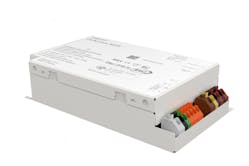Acuity’s eldoLED LED driver business unit has announced the first driver products to receive Digital Illumination Interface Alliance (DiiA) certification to DALI (Digital Addressable Lighting Interface)-2 Tc, with Tc referring to white-point color temperature control along the black-body line.. Such drivers will generally be multi-channel products, yet a single DALI address and command stream will control two or more driver outputs. Meanwhile, eldoLED has already supplied the DUALdrive DALI-2 Tc drivers to a project revealed in December at the Forum Groningen shopping and entertainment facility in the Netherlands.
DALI-2 has been in the works for some time now, at this point being promulgated by the DiiA. Back in 2017, we published a feature article that detailed some of the features and benefits of the revised interface standard. As the article discusses, the revisions came with the expectation that products would undergo a certification process to ensure interoperability between products from different vendors.
There is some ambiguity in terminology related to the DALI-2 standards, parallel standards work by the IEC, and how Acuity has utilized the terminology. Acuity uses the term Device Type 8 (DT8) in referring to its drivers. DT8 relates to Part 209 of the IEC62386 standard that is aligned with the DiiA DALI-2 work. But the DiiA does not utilize the DT8 designation and asserts that the Tc designation is more important as it specifically relates to white-point-tunable systems and not full-color systems.
Acuity has initially implemented the DT8 capability in the DUALDrive 562 model, and Acuity has also referred to the product as a DALI 209 driver, referencing section 209 of the IEC, although the DiiA has said that is not proper usage of terminology. Still, it’s clear what Acuity means with this quote: "DT8 certification is the culmination of eldoLED's latest effort to elevate color science and is a significant step forward in our quest to bring digital solutions to market, simplify solution development, and drive the quality of light in LED systems," said Gilles Abrahamse, vice president of digital luminaire components at Acuity . "Reducing the number of addresses simplifies design and commissioning as evidenced during eldoLED's Groningen installation.”
The Forum Groningen installation, meanwhile, involved more than 1000 tunable white luminaires. The system can set output in the range of 2500K CCT to 4000K CCT. The adjustment in chromaticity is said to be continuous and dimming is down to 0.1%. The products are based on what Acuity calls LightShape technology.
DALI-2, meanwhile, enables many more things in the SSL sector. For example, we covered the use of the technology in intra-luminaire applications after the DiiA announced what it calls D4i interface last year. We also wrote a feature article on how the internal use of DALI-2 inside luminaires could pave a smoother path forward to smart lighting systems in buildings.
Back to Acuity, the company said the industry should expect more DT8 drivers soon or what the company is also calling type Tc drivers. Indeed, expect other members of the DUALdrive portfolio to get a DT8 upgrade. And the company plans to support DT8 in its LINEARdrive products. Models from both portfolios are currently undergoing certification.
*Updated Feb 25, 2020 5:03 PM to reflect new information from the Digital Illumination Interface Alliance (DiiA).






